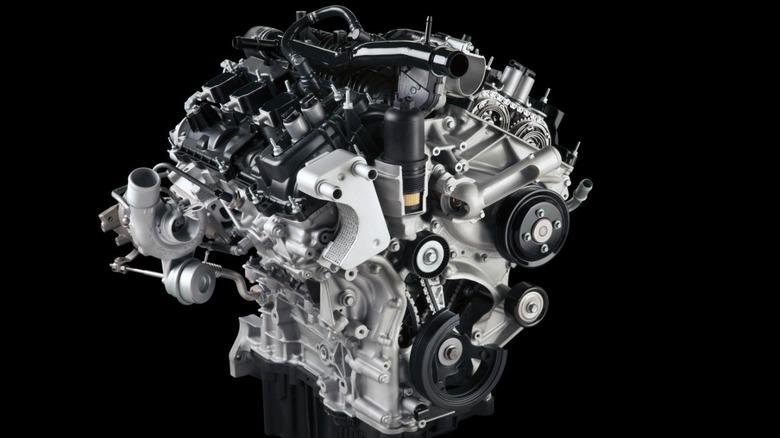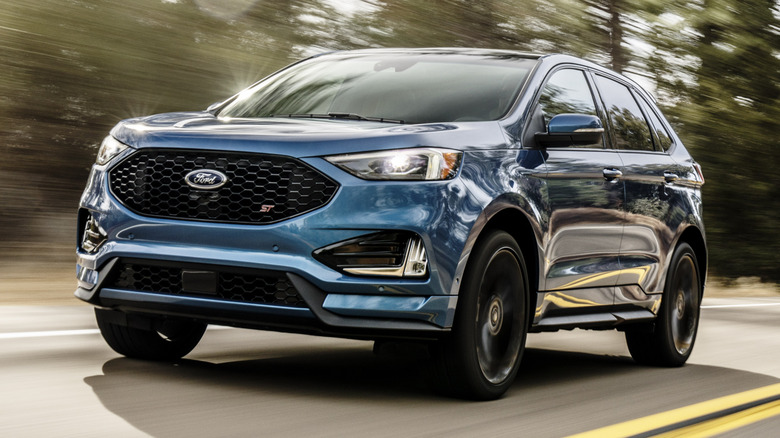Ford 2.7 EcoBoost Engine: What's Different Between The Nano's Gen 1 & 2?
Many Ford vehicles now use the brand's EcoBoost engines for fuel efficiency reasons. Among them, the Ford 2.7 EcoBoost Nano seems like one of the most satisfying to own, with many owners finding it generally reliable. This 2.7-liter, twin-turbocharged V6 was first introduced in the 2015 Ford F-150, where it delivered 325 hp and 375 lb-ft of torque. With that, the 2.7 EcoBoost-powered F-150 could tow up to 8,500 pounds and carry a maximum payload of 2,250 pounds. Fuel economy was also decent for a full-size truck, at 22 mpg combined, according to the EPA.
For the 2018 model year, Ford updated the 2.7 EcoBoost V6, adding new turbochargers and a variable-displacement oil pump while also reducing internal friction, all to enhance engine reliability and efficiency. This Nano Gen 2 EcoBoost V6 came paired with a new 10-speed automatic transmission instead of the six-speed automatic that accompanied the first-generation engine.
Despite the changes, however, the second-generation 2.7 EcoBoost Nano V6 didn't see any horsepower gains, with output remaining the same at 325 hp. However, the updated engine's 400 lb-ft of torque was 25 pounds more than what the Gen 1 2.7 EcoBoost produced. Powered by this reworked engine, a 2018 Ford F-150 4x2 SuperCrew truck could hit 60 mph in 5.9 seconds, according to Car and Driver. That's 0.8 seconds faster than a two-wheel-drive 2015 model, which has a 6.7-second 0-60 time. Efficiency-wise, the second-gen 2.7 EcoBoost engine in the F-150 returned the same average fuel economy figure of 22 mpg as the Gen 1 model.
The second-generation 2.7 EcoBoost gained dual fuel injection
Although the Gen 2 Ford 2.7 EcoBoost V6 engine brought a host of changes, the switch to a dual fuel injection system was one of its major highlights. The first-generation 2.7 EcoBoost engine uses only direct injection technology, where fuel is injected directly into the combustion chamber in order to be burned off. Conversely, the second-generation engine has both direct and conventional port fuel injection, which typically sprays fuel at the back of the intake valve.
Ford's decision to add port fuel injection was likely influenced by the shortcomings of the direct-injected Gen 1 engine. Because direct injection squirts fuel directly into the combustion chamber, some Gen 1 EcoBoost engines had a reputation for carbon buildup on the intake valves and ports, since fuel wasn't being sprayed across the intake valves to wash off the deposits. The addition of port injection was plausibly Ford's way of counteracting the carbon build-up issue; by spraying fuel into the port and onto the back of the valve, the injector gets to wash carbon deposits from valves, ensuring higher exhaust gas recirculation rates.
Speaking of which, Ford also equipped the second-gen 2.7 EcoBoost V6 Nano engine with a new exhaust gas recirculation system (EGR) in an effort to ensure that exhaust gases were circulated back into the intake system more efficiently.
What other Fords use the 2.7 EcoBoost?
The Ford 2.7 EcoBoost V6 engine offers many appealing traits that make it ideal for use in many Ford and Lincoln vehicles. It's a square design, with its stroke length and bore diameter both measuring 3.27 inches. The cylinder block, meanwhile, is constructed of compacted graphite iron (CGI) — the same durable material used in Ford's 6.7-liter Power Stroke turbo diesel V8. Also part of the 2.7 EcoBoost package is auto start-stop technology, which detects when the vehicle is idling — such as in congested traffic, at traffic lights, or when waiting in a queue — and shuts off the engine automatically to save fuel.
Hence, the 2.7 EcoBoost engine has been used in all sorts of production vehicles, from trucks to passenger cars and off-road-going SUVs. The second-generation Nano V6, for one, has powered the Ford Edge ST, Ford Ranger, and Ford Bronco, all with different power outputs. In the current-generation Ford Bronco, it makes 310–330 hp and 400-415 lb-ft, whereas the power rating for the fifth-generation Ford Ranger introduced for 2024 is slightly less than that max figure at 315 hp and 400 lb-ft. The most powerful version of the Gen 2 Ford 2.7 EcoBoost Nano V6 was in the Ford Edge ST, where it made 335 hp and 380 lb-ft of torque. Impressive as this may seem, the Gen 1 EcoBoost 2.7 V6 was more widely used, as it featured beneath the hoods of the Ford F-150, Lincoln Continental, Ford Edge Sport, Ford Fusion Sport, and Lincoln MKX, among others.


